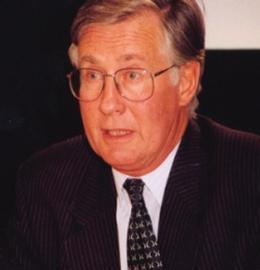Wyatt's message was adapt or die. "Although we have been a very successful industry, and have taken on many extra functions to deliver added value, the warning signals are mounting. Very rapid change is underway within construction and we need to respond quickly, creatively and with focus – or a substantial part of our work may disappear."
Although his speech was positive about the future for building services, Wyatt made it clear that there is no room for prevarication. He cited farming, fishing, shipbuilding, textiles and mining as examples of industries that had failed to adapt – and which had gone on to suffer the consequences.
His speech was greeted with enthusiasm by the many members of CIBSE who heard the speech, and Michael Meacher MP, Minister for the Environment, offered his own congratulations to CIBSE for putting sustainability at the heart of its agenda.
"Central government is taking sustainability with increasing seriousness. My department is leading. We share a belief. We must all embrace it," commented the minister.
He also said that as well as being an Institutional goal, sustainability must also be be an organisational target. "We in government are trying to integrate sustainable development into the heart of government decision making. I urge everyone here to put sustainable development at the heart of your company's decision making."
Meacher harked back to his 2000 challenge to CIBSE in which the Institution was asked to report to the minister with a 'measurable and quantifiable action plan that will deliver greater energy efficiency in the built environment'.
At the time, CIBSE rose to the challenge. "On presenting your action plan to me, CIBSE President at the time David Wood recognised new buildings must be more sustainable and energy performance of existing building stock must improve markedly," said Meacher.
The minister also added that he was much encouraged by Wyatt's chairing of the CIBSE Carbon Task Group to promote low-carbon solutions, prepare for the EU Directive on Energy Performance of ÐÇ¿Õ´«Ã½s, and to make CIBSE a 'carbon neutral' organisations.
But Meacher himself asked the question that many were already thinking: "What is the government itself doing about it?"
In answer to the question, Meacher pointed out that the government estate includes 19 central departments, 50 000 buildings, and 600 000 staff – a diverse challenge. He highlighted the fact that the majority of government refurbishments have used non-hfc alternatives in refrigeration and air conditioning systems. He cited the example of ammonia systems being installed in the International Maritime Organisation building. The Treasury building also uses natural ventilation.
The government has been taking a progressive approach to targeting environmental practices around its buildings. "Last year it was environmental management systems, public reporting, travel, water. Next year it will be waste, energy, procurement, estates management (including construction) and biodiversity," said Meacher. The aim for government is to tackle the full range of impacts, and report publicly. "Evidence that government is practising what we preach."
Meacher also took the opportunity to ask CIBSE to prove that it too is playing its part effectively: "I now make another challenge to you. Provide evidence of delivery against your action plan across all of the sectors that your Institution represents." Wyatt welcomed the new challenge and said that it would form the focal point for the Carbon Task Group's future work.
In recent times, the government has also made public commitments to sustainability through legislation, particularly the Energy White Paper. But although the industry is keen to encourage the government in its steps towards sustainability, there have been calls for government to take a firmer stand. For example, energy efficiency groups would like to see a clearer commitment to their cause, by including targets for efficiency. There are also still issues with NETA and its negative effects on the financial viability of sustainable energy sources such as wind power.
Source
ÐÇ¿Õ´«Ã½ Sustainable Design


















No comments yet